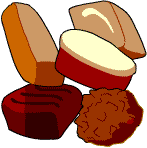Chocolate - the Good Old Days
Created | Updated Nov 4, 2004

Let's get this clear from the start - I like chocolate. The following text was taken from a book I read recently, entitled 'Cocoa and Chocolate, Their Chemistry and Manufacture', by R. Whymper. The book was first published in 1912, and the words below are from the preface to the second edition published in 1921 (long before such things as ISBNs and now long out of copyright). To me, it's a fascinating look back in time. I've removed a few of the less interesting paragraphs, and footnoted a few comments.
Since the date of the first publication of this work, much water has flowed under London Bridge* . It is difficult to think back to the good old days* when necessities and commodities were cheap, and the public appetite was normal. It was then perfectly possible to say what a machine would cost and to predict the day of delivery. It was possible to foresee, to some extent, the trend of public fancy*, and to guide its taste in certain directions.
To-day*, none of these things is possible. The chocolate industry is immense and growing very rapidly. There are, also, on the one hand, high prices ruling labour and the cost of materials, and a general shortage of necessary ingredients, whilst, on the other hand, the increasing demand for sweet things does not ease the situation. Even now it is not possible to say how long the public will continue to pay the very high prices for cocoa and chocolate, nor is it possible to predict whether, in the immediate future, the market value of sugar and cacao* will go up or down. The even distribution of these ingredients over the world, according to demand, has not yet taken place, and the consumption of sweet things, though still very great, must fall sooner or later, if prices continue to rise.
...
...Generally speaking, the quality of cocoa and chocolate was very good in Europe before 1914, and the manufacturer devoted much time, money and thought to his product. Then came the war and a greatly increased demand for cocoa confections, a shortage of ingredients, and labour difficulties*. It was inevitable that radical changes should be introduced into the factory. But what then of the quality of the product?
Speaking as one who consumed in those dark days more chocolate than ever previously in his lifetime, I am aware that, at first, I was severely critical, but later, with palate possibly spoiled by too much tobacco, whiskey*, bully-beef and biscuits, almost any chocolate was chocolate, sweet and palatable...
...
I have had exceptional opportunities of studying this new side of the chocolate industry, as I have returned to face the problems with a fresh outlook and have also had the advantage of visiting the United States of America in the latter part of 1919 and in early 1920.
The American is not hampered by precedent and is ever prepared to try new ideas. Moreover, he is a 'quantity' specialist and, very naturally, wide-awake to any measures that will increase output. Further than this, his output of chocolate is much below that demanded by the public. America, therefore, may be said to be in much the same condition now as this country was during the war, with the exception that the American public has never been educated to the standard of chocolate, demanded by the European. The American manufacturer can, then, put upon the market and readily sell products that would not be considered 'best quality' in Europe*, and it is my opinion that his reputation, on this side, has suffered adversely* from the chocolates he has thought fit to send us during our famine.*
This condition, I feel certain, will change in the very near future. Chocolate factories are springing up like mushrooms* all over America, whose soil, moistened by the beer and wine that has been spilt*, and warmed by the enthusiasm of 'Pussyfoot'*, has become particularly suitable for upstart industries of this kind. Doubtless*, posterity will bless the accomplishment of 'prohibition' and, incidentally, will reap the advantage of better chocolate, for competition will be very severe.
Chocolates made in America and Europe to-day are, respectively, as different as chalk from cheese*. Perhaps the European taste is that of a blasé epicure; perhaps the American palate is uncultured. I will not take it upon myself to pass judgement*. But, and I can say this with some assertion, chocolate made in the good old-fashioned way, with careful consideration paid to every detail, to ingredients and to processes of manufacture, is still unequalled for delicacy of flavour and aroma by any chocolate manufactured by short-cut methods.*
